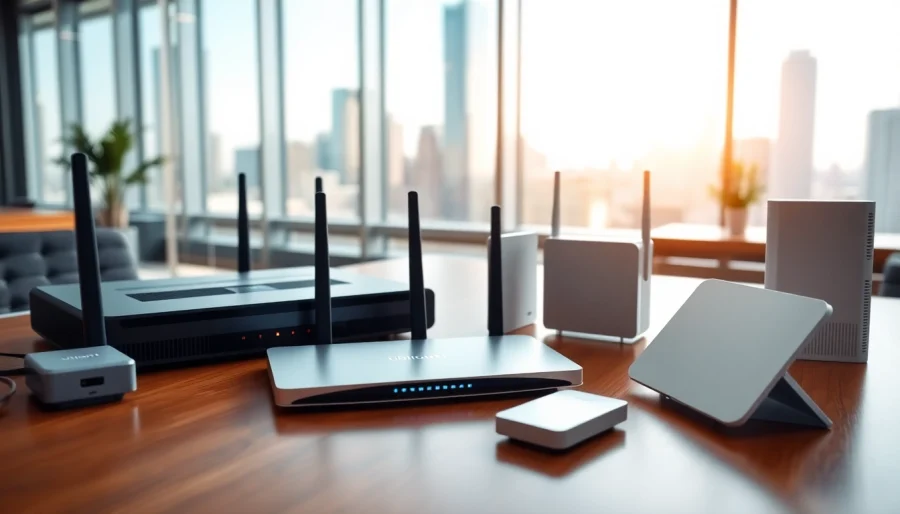Introduction to Ubiquiti Networking
In an era where connectivity is paramount, Ubiquiti has emerged as an influential player in the networking landscape. With innovative solutions designed to improve network efficiency, scalability, and security, Ubiquiti’s comprehensive product range has redefined how businesses and individual users approach their networking needs. This article delves into the core principles, technologies, and advanced features that Ubiquiti offers, providing insights and practical knowledge for users who seek to maximize their networking capabilities.
What is Ubiquiti?
Ubiquiti Networks is a technology company that specializes in wireless data communication and wired products, crafted for both enterprises and homes. The company is known for its user-friendly designs and sophisticated software solutions, enabling users to manage their networks seamlessly. Its popular product lines include UniFi, airMAX, and EdgeMAX, each tailored to meet distinct networking requirements, from home use to large-scale enterprise solutions.
Core Technologies of Ubiquiti
At the heart of Ubiquiti’s offerings are several core technologies that set it apart from traditional network solutions:
- Wireless Communication: Ubiquiti devices utilize advanced MIMO (Multiple Input Multiple Output) technology, enhancing data throughput and link stability.
- Cloud Control: The UniFi Controller software allows for centralized management of network devices, simplifying the administration of large networks.
- Scalable Solutions: With a range of products designed to work cohesively, Ubiquiti ensures that networks can grow in line with user needs.
Benefits of Ubiquiti for Businesses
Employing Ubiquiti networking solutions yields numerous benefits:
- Cost-Effective: Compared to other professional-grade networking solutions, Ubiquiti products are competitively priced without sacrificing quality.
- Easy Deployment: The intuitive setup process allows businesses to get systems running quickly and efficiently.
- Robust Community Support: Active online forums provide users with solutions, user-generated content, and best practices.
Setting Up Your Ubiquiti Network
Essential Hardware and Tools
Setting up a Ubiquiti network requires specific hardware and tools, including:
- Access Points: Critical for providing wireless connectivity.
- Switches: Enable wired connections and ensure sufficient bandwidth.
- Router: Directs data and manages internet connectivity.
- Controller Software: Essential for network management.
Step-by-Step Installation Guide
To successfully install a Ubiquiti network, follow these steps:
- Identify Your Network Layout: Map out where devices will be placed to ensure optimal coverage.
- Connect Your Hardware: Start by physically connecting the router to the internet source and the switches to the router.
- Install Access Points: Position access points strategically to eliminate dead zones, connecting them to the switch via Ethernet cables.
- Configure the Controller: Download the UniFi Controller software, follow the setup prompts to configure your network settings.
Troubleshooting Common Setup Issues
While setting up your network, you may encounter issues. Here are solutions to common problems:
- Access Points Not Broadcasting: Check power connections and ensure that the firmware is updated.
- Slow Network Speed: Examine the bandwidth and adjust device allocations through the controller.
- Configuration Errors: Revisit the setup guide to verify that each step was followed correctly.
Optimizing Ubiquiti Performance
Configuring Network Settings
To achieve the best performance from your Ubiquiti network, customize the following settings:
- SSID Management: Set unique SSIDs for different areas to manage user access effectively.
- Channel Selection: Manually selecting wireless channels can reduce interference from neighboring networks.
- Quality of Service (QoS): Implement QoS settings to prioritize bandwidth for critical applications.
Best Practices for Bandwidth Management
Efficient bandwidth management ensures that users experience minimal disruption:
- Limit Guest Access: Set restrictions on bandwidth for guest users to ensure premium users get sufficient resources.
- Monitor Usage Patterns: Use the statistics provided in the UniFi Controller to identify bandwidth-hogging devices.
- Regular Updates: Keep device firmware and software updated to benefit from improvements in performance and security.
Monitoring and Diagnostics Tools
Ubiquiti offers several tools for monitoring network performance:
- UniFi Dashboard: Provides a visual interface for real-time usage statistics and device status.
- Network Scanner: Identifies active devices and detects potential network vulnerabilities.
- Alert System: Configurable notifications for unusual activities, allowing for swift responses.
Advanced Features of Ubiquiti
Utilizing Smart Access Points
Smart access points enhance network management and performance through features such as:
- Band Steering: Encourages dual-band devices to connect to the 5GHz band to reduce congestion.
- Mesh Networking: Facilitates connections between access points to extend the network range seamlessly.
Exploring Network Security Options
A robust network security strategy is crucial. Ubiquiti enables enhanced security via:
- Segmentation: The ability to create separate networks for guests, IoT devices, and administrative access.
- Firewall Features: Integrated firewall settings that can be configured within the UniFi Controller.
- Data Encryption: Ensures data is encrypted during transmission, protecting user privacy.
Implementing Custom Solutions for Businesses
Ubiquiti’s flexibility allows businesses to design customized network solutions:
- VLANs: Virtual Local Area Networks can be established for different departments, enhancing traffic management.
- Remote Access: Configure secure remote access for remote workers without compromising network integrity.
Evaluating Ubiquiti Success Metrics
Expected Performance Outcomes
When properly configured, Ubiquiti networks can achieve remarkable outcomes:
- Improved Speed: Users commonly report higher data speeds across both wired and wireless connections.
- Increased Reliability: Consistently connected devices with minimal downtime enhance productivity.
Measuring User Experience
Evaluating user experience within a Ubiquiti network can be achieved through:
- User Feedback: Collecting feedback from users to identify pain points.
- Network Performance Metrics: Monitoring latency and connection strength can inform adjustments.
Continuous Improvement Strategies
To maintain optimal performance, implement continuous improvement strategies such as:
- Regular Review Sessions: Schedule periodic assessments of network performance and user satisfaction.
- Stay Informed: Keep up with Ubiquiti’s software updates and new technologies.
- Community Engagement: Participating in forums and user groups can provide valuable insights and innovative solutions.
